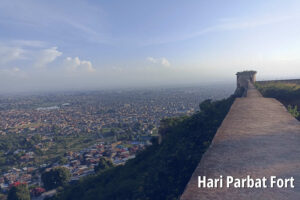Introduction
 Nestled amidst the picturesque landscapes of the Kashmir Valley, the Hari Parbat Fort stands as a testament to the rich history and architectural prowess of the region. Situated on the outskirts of Srinagar, the capital city of the Indian Union territory of Jammu and Kashmir, this historic fort has witnessed centuries of cultural, political, and architectural evolution. Its unique blend of Mughal, Persian, and Kashmiri architectural elements, coupled with its strategic location, makes it a remarkable site that continues to draw history enthusiasts and tourists alike.
Nestled amidst the picturesque landscapes of the Kashmir Valley, the Hari Parbat Fort stands as a testament to the rich history and architectural prowess of the region. Situated on the outskirts of Srinagar, the capital city of the Indian Union territory of Jammu and Kashmir, this historic fort has witnessed centuries of cultural, political, and architectural evolution. Its unique blend of Mughal, Persian, and Kashmiri architectural elements, coupled with its strategic location, makes it a remarkable site that continues to draw history enthusiasts and tourists alike.
Historical Significance
The history of Hari Parbat Fort dates back to the Mughal era, specifically the reign of Emperor Akbar in the late 16th century. It was during his rule that the foundation for the fort was laid. The construction of the fort continued through the subsequent reigns of Jahangir and Shah Jahan. The fort was initially named “Praghaspura” after Emperor Akbar’s son, and later, its name was changed to “Hari Parbat,” meaning “Hari’s Mountain,” in reference to the sacredness of the site.
One of the distinctive features of the fort is the hill on which it is located. The hill is considered sacred by Hindus, Muslims, and Sikhs alike, further enhancing the fort’s cultural and religious significance.
Architectural Marvel
The architecture of Hari Parbat Fort reflects the amalgamation of various styles. The outer walls of the fort are characterized by their strong defensive features, including bastions and intricately designed gateways. The Mughal influence is evident in the use of red sandstone, which gives the fort its distinctive appearance. The inner structures exhibit Persian architectural elements, such as ornate balconies and detailed stucco work.
Within the fort complex lies the historic Makhdoom Sahib Shrine, a revered Sufi shrine that attracts pilgrims and devotees from all walks of life. The shrine’s architecture showcases fine woodwork, intricate lattice screens, and the use of vibrant colors that are reminiscent of Kashmiri craftsmanship.
Cultural and Religious Significance
Hari Parbat Fort is not merely a historical relic; it holds profound cultural and religious importance. The hill on which the fort stands is believed to house a sacred cave associated with the Hindu deity Shakti. Additionally, the hill is said to be the site where the sage Kashyapa bound the demon Jalodbhava in ancient Hindu mythology. The surrounding areas also hold spiritual significance for Muslims, with the revered shrine of Makhdoom Sahib being a focal point for Sufi devotees.
Preservation Efforts and Tourism
Over the years, Hari Parbat Fort has faced its share of challenges, including natural decay and political unrest. However, efforts have been made by various stakeholders to preserve and restore the fort’s architectural heritage. The fort is open to tourists, and its historical and religious significance makes it a popular destination for both domestic and international visitors.
Conclusion
The Hari Parbat Fort stands as a living testament to the rich and diverse history of the Kashmir Valley. Its architectural marvel, cultural significance, and religious importance make it a symbol of the region’s unity in diversity. As visitors explore the fort’s intricate structures and learn about its historical narrative, they are reminded of the enduring legacy that this magnificent fort represents.


